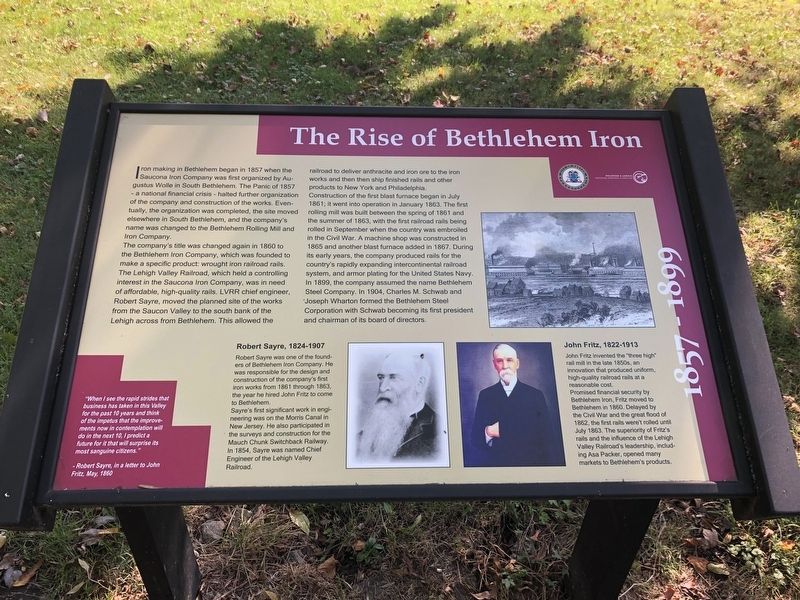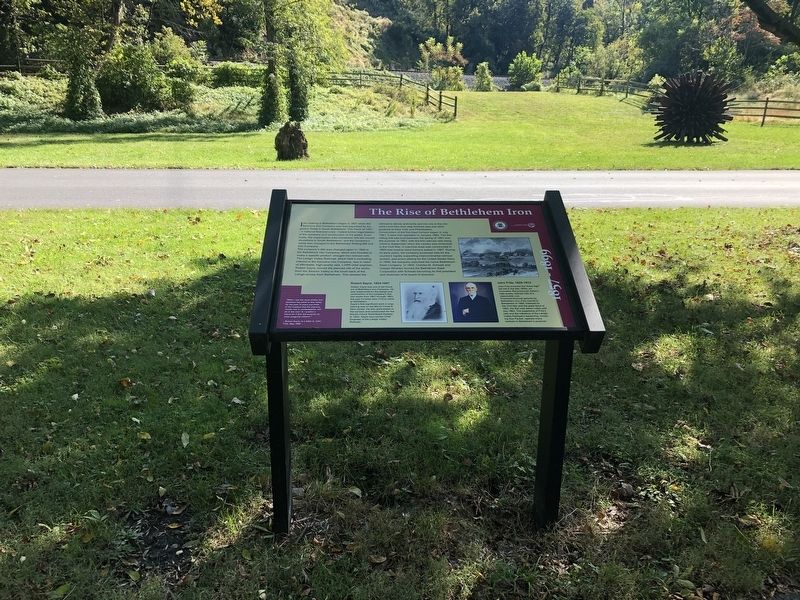Easton in Northampton County, Pennsylvania — The American Northeast (Mid-Atlantic)
The Rise of Bethlehem Iron
1857 - 1899
Iron making in Bethlehem began in 1857 when the Saucona Iron Company was first organized by Augustus Wolle in South Bethlehem. The Panic of 1857 — a national financial crisis — halted further organization of the company and construction of the works. Eventually, the organization was completed, the site moved elsewhere in South Bethlehem, and the company's name was changed to the Bethlehem Rolling Mill and Iron Company.
The company's title was changed again in 1860 to the Bethlehem Iron Company, which was founded to make a specific product: wrought iron railroad rials. The Lehigh Valley Railroad, which held a controlling interest in the Saucona Iron Company, was in need of affordable, high-quality rails. LVRR chief engineer, Robert Sayre, moved the planned site of the works from the Saucon Valley to the south bank of the Lehigh across from Bethlehem. This allowed the railroad to deliver anthracite and iron ore to the iron works and then then ship finished rails and other products to New York and Philadelphia. Constructed of the first blast furnace began in July 1861; it went into operation in January 1863. The first rolling mill was built between the spring of 1861 and the summer of 1863, with the first railroad rails being rolled in SEptember when the country was embroiled in the Civil War. A machine shop was constructed in 1865 and another blast furnace added in 1867. During its early years, the company produced rails for the country's rapidly expanding intercontinental railroad system, and armor plating for the United States Navy. In 1899, the company assumed the name Bethlehem Steel Company. In 1904, Charles M. Schwab and Joseph Wharton formed the Bethlehem Steel Corporation with Schwab becoming its first president and chairman of its board of directors.
"When I see the rapid strides that business has taken in this Valley for the past 10 years and think of the impetus that the improvements now in contemplation will do in the next 10, I predict a future for it that will surprise its most sanguine citizens."
— Robert Sayre, in a letter to John Fritz, May, 1860
Robert Sayre, 1824-1907
Robert Sayre was one of the founders of Bethlehem Iron Company. He was responsible for the design and construction of the company's first iron works from 1861 through 1863, the year he hired John Fritz to come to Bethlehem.
Sayre's first significant work in engineering was on the Morris Canal in New Jersey. He also participated in the surveys and construction for the Mauch Chunk Switchback Railway. In 1854, Sayre was named Chief Engineer of the Lehigh Valley Railroad.
John
John Fritz invented the "three high" rail mill in the late 1850s, an innovation that produced uniform, high-quality railroad at a reasonable cost.
Promised financial security by Bethlehem IRon, Fritz moved to Bethlehem in 1860. Delayed by the Civil War and the great flood of 1862, the first rails were't rolled until July 1863. The superiority of Fritz's rails and the influence of the Lehigh Valley Railroad's leadership, including Asa Packer, opened many markets to Bethlehem's products.
Erected by City of Easton, Pennsylvania.
Topics. This historical marker is listed in these topic lists: Industry & Commerce • Railroads & Streetcars. A significant historical month for this entry is January 1863.
Location. 40° 39.918′ N, 75° 14.272′ W. Marker is in Easton, Pennsylvania, in Northampton County. Marker is on Hugh Moore Park Road, 0.3 miles south of Hill Road, on the right when traveling south. Touch for map. Marker is at or near this postal address: 358 Hugh Moore Park Rd, Easton PA 18042, United States of America. Touch for directions.
Other nearby markers. At least 8 other markers are within walking distance of this marker. Easton's Abbot Street Area (within shouting distance of this marker); The Glendon Iron Works (within shouting distance of this marker); Anthracite Iron - A Revolution Is Born (about 500 feet away, measured in a direct line); From Mine to Market (approx. 0.2 miles away); Mules and Men (approx. 0.2 miles away); Lehigh Crane Iron Company (approx. 0.2 miles away); The Promise of Anthracite Coal (approx. 0.2 miles away); From Mountain to Market (approx. 0.2 miles away). Touch for a list and map of all markers in Easton.
Credits. This page was last revised on October 8, 2020. It was originally submitted on October 5, 2020, by Devry Becker Jones of Washington, District of Columbia. This page has been viewed 265 times since then and 36 times this year. Photos: 1, 2. submitted on October 5, 2020, by Devry Becker Jones of Washington, District of Columbia.

